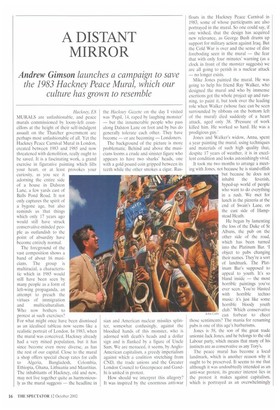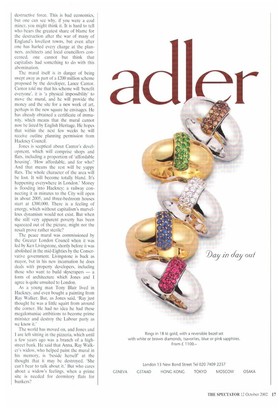A DISTANT MIRROR
Andrew Gimson launches a campaign to save
the 1983 Hackney Peace Mural, which our culture has grown to resemble
Hackney. E8 MURALS are unfashionable, and peace murals commissioned by loony-left councillors at the height of their self-indulgent assault on the Thatcher government are perhaps most unfashionable of all. Yet the Hackney Peace Carnival Mural in London, created between 1983 and 1985 and now threatened with demolition, really ought to be saved. It is a fascinating work, a grand exercise in figurative painting which lifts your heart, or at least provokes your curiosity, as you see it adorning the entire side of a house in Dalston Lane, a few yards east of Balls Pond Road. It not only captures the spirit of a bygone age, but also reminds us that things which only 17 years ago would still have struck conservative-minded people as outlandish to the point of absurdity have become entirely normal.
The foreground of the vast composition shows a band of about 16 musicians. The group is multiracial, a characteristic which in 1985 would still have been seen by many people as a form of left-wing propaganda, an attempt to preach the virtues of immigration and multiculturalism. Who now bothers to protest at such exercises?
For what might once have been dismissed as an idealised tableau now seems like a realistic portrait of London. In 1983, when the mural was conceived, Hackney already had a very mixed population, but it has since become even more diverse, as has the rest of our capital. Close to the mural a shop offers special cheap rates for calls to Algeria, Bangladesh, Colombia, Ethiopia, Ghana, Lithuania and Mauritius. The inhabitants of Hackney, old and new, may not live together quite as harmoniously as the mural suggests — the headline in the Hackney Gazette on the day I visited was 'Pupil, 14, raped by laughing monster' — but the innumerable people who pass along Dalston Lane on foot and by bus do generally tolerate each other, They have become — or are becoming — Londoners.
The background of the picture is more problematic. Behind and above the musicians looms a crude and sinister figure who appears to have two sharks' heads, one with a gold pound coin gripped between its teeth while the other smokes a cigar. Rus sian and American nuclear missiles splinter, somewhat confusingly, against the bloodied hands of this monster, who is adorned with death's heads and a dollar sign and is flanked by a figure of Uncle Sam. We are menaced, it seems, by AngloAmerican capitalism, a greedy imperialism against which a coalition stretching from CND, the trade unions and the Greater London Council to Greenpeace and Gandhi is united in protest.
How should we interpret this allegory? It was inspired by the enormous anti-war
floats in the Hackney Peace Carnival in 1983. some of whose participants are also portrayed in the mural. So one could say, if one wished, that the design has acquired new relevance, as George Bush drums up support for military action against Iraq. But the Cold War is over and the sense of dire foreboding seen in the mural — the fear that with only four minutes' warning (as a clock in front of the monster suggests) we are all going to perish in a nuclear attack — no longer exists.
Mike Jones painted the mural. He was going to help his friend Ray Walker, who designed the mural and who by immense exertions got the whole project up and running, to paint it, but took over the leading role when Walker (whose face can be seen surrounded by ribbons on the bottom left of the mural) died suddenly of a heart attack, aged only 38. 'Pressure of work killed him. He worked so hard. He was a prodigious guy.'
Jones and Walker's widow, Anna, spent a year painting the mural, using techniques and materials of such high quality that, despite 17 years of weather, it is in excellent condition and looks astonishingly vivid.
It took me two months to arrange a meeting with Jones, not because he is stand-offish but because he does not inhabit the feverish, hyped-up world of people who want to do everything in a rush, We met for lunch in the pizzeria at the end of Swain's Lane, on the east side of Hampstead Heath.
He began by lamenting the loss of the Duke of St Albans, the pub on the other side of the road, which has been turned into the Platinum Bar. 'I object to pubs changing their names. They're a sort of landmark. The Platinum Bar's supposed to appeal to youth. It's so bland inside — the most horrible paintings you've ever seen. You're blasted with horrible techno music: it's just like some horrible bloody youth club.' Which conservative
John Cobb can forbear to cheer those sentiments? The mania for renaming pubs is one of this age's barbarisms.
Jones is 58, the son of the great trade unionist Jack Jones, and he belongs to the old Labour party, which means that many of his instincts are as conservative as any Tory's.
The peace mural has become a local landmark, which is another reason why it ought to be preserved. It seems to me that although it was undoubtedly intended as an anti-war protest, its greater interest lies in the protest it makes against capitalism, which is portrayed as an overwhelmingly destructive force. This is bad economics, but one can see why, if you were a coal miner, you might think it. It is hard to tell who bears the greatest share of blame for the destruction after the war of many of England's loveliest towns, but even after one has hurled every charge at the planners, architects and local councillors concerned, one cannot but think that capitalists had something to do with this abomination.
The mural itself is in danger of being swept away as part of a £200 million scheme proposed by the developer, Lance Cantor. Cantor told me that his scheme will 'benefit everyone', it is 'a physical impossibility' to move the mural, and he will provide the money and the site for a new work of art, perhaps in the new square he envisages. He has already obtained a certificate of immunity, which means that the mural cannot now be listed by English Heritage. He hopes that within the next few weeks he will receive outline planning permission from Hackney Council.
Jones is sceptical about Cantor's development, which will comprise shops and flats, including a proportion of 'affordable housing'. 'How affordable, and for who? And that means the rest will be yuppy flats. The whole character of the area will be lost. It will become totally bland. It's happening everywhere in London.' Money is flooding into Hackney; a railway connecting it in minutes to the City will open in about 2005, and three-bedroom houses start at £300,000, There is a feeling of energy, which without capitalism's marvellous dynamism would not exist. But when the still very apparent poverty has been squeezed out of the picture, might not the result prove rather sterile?
The peace mural was commissioned by the Greater London Council when it was led by Ken Livingstone, shortly before it was abolished in the mid-Eighties by the Conservative government_ Livingstone is back as mayor, but in his new incarnation he does deals with property developers, including those who want to build skyscrapers — a form of architecture which Jones and I agree is quite unsuited to London.
As a young man Tony Blair lived in Hackney, and even bought a painting from Ray Walker. But, as Jones said, 'Ray just thought he was a little squirt from around the corner. He had no idea he had these megalomaniac ambitions to become prime minister and destroy the Labour party as we know it.'
The world has moved on, and Jones and I are left sitting in the pizzeria, which until a few years ago was a branch of a highstreet bank. He said that Anna, Ray Walker's widow, who helped paint the mural in his memory, is 'beside herself at the thought that it may be destroyed. 'She can't bear to talk about it.' But who cares about a widow's feelings, when a prime site is needed for dormitory flats for bankers?



































































































 Previous page
Previous page